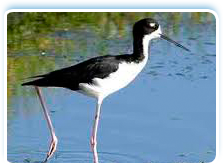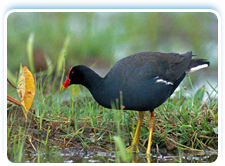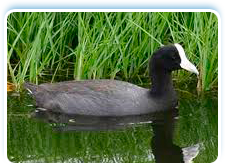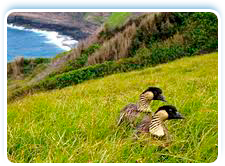|
||||||||||||||||||||||||||||||||||||||||||
 |
 |
|||||||||||||||||||||||||||||||||||||||||
| The Endangered Species Act of 28 December 1973 (USFWS and NOAA) signed by Nixon protects five very endangered native Hawaiian waterbirds: the stilt, coot, moorhen, duck, and goose. These birds were once abundant throughout the Hawaiian Islands, but due to diminished habitat, predation and a variety of other causes their populations have dwindled severely. Kaua'i is unique among all of the Hawaiian Islands in that the mongoose was not established here so as a result eggs and small birds are somewhat safer here. The ESA by creating protection of the species and also the ecosystems upon which they depend has indeed become the Magna Carta of the environmental movement. | ||||||||||||||||||||||||||||||||||||||||||
| Hawaiian Stilt (Ae'o - 1,600) The Hawaiian Stilt use a variety of aquatic habitats limited by water depth and vegetation cover. If you have seen their pink legs you know they love about 5 inches of water... read more |
Hawaiian Moorhen ('Alae 'Ula - 750) In Hawaiian mythology, a moorhen brought fire to humans which explains the red on its forehead, a symbol of the scorching from the fire. In the 1960's the moorhen... read more |
|||||||||||||||||||||||||||||||||||||||||
 |
 |
 |
||||||||||||||||||||||||||||||||||||||||
| Hawaiian Coot ('Alae Ke'oke'o - 5,000) The Hawaiian Coot is a dark grey bird which from a distance looks black with a large bulbous white frontal shield. Their legs are dull green. They are present from sea level to 500 feet. read more |
Hawaiian Goose (Néné - 2,500) The Official State Bird of Hawaii since 1957 when their population was down to 30 individuals. It is the world's rarest goose with only around 3,159 living in the wild, mostly on Kaua'i.. read more |
Hawaiian Duck (Koloa Maoli - 2,200) The range of the pure Hawaiian duck is now restricted to and only found on the island of Kaua'i. It is a very wary bird often found in pairs instead of large groups. They are very secretive and do not... read more |
||||||||||||||||||||||||||||||||||||||||








